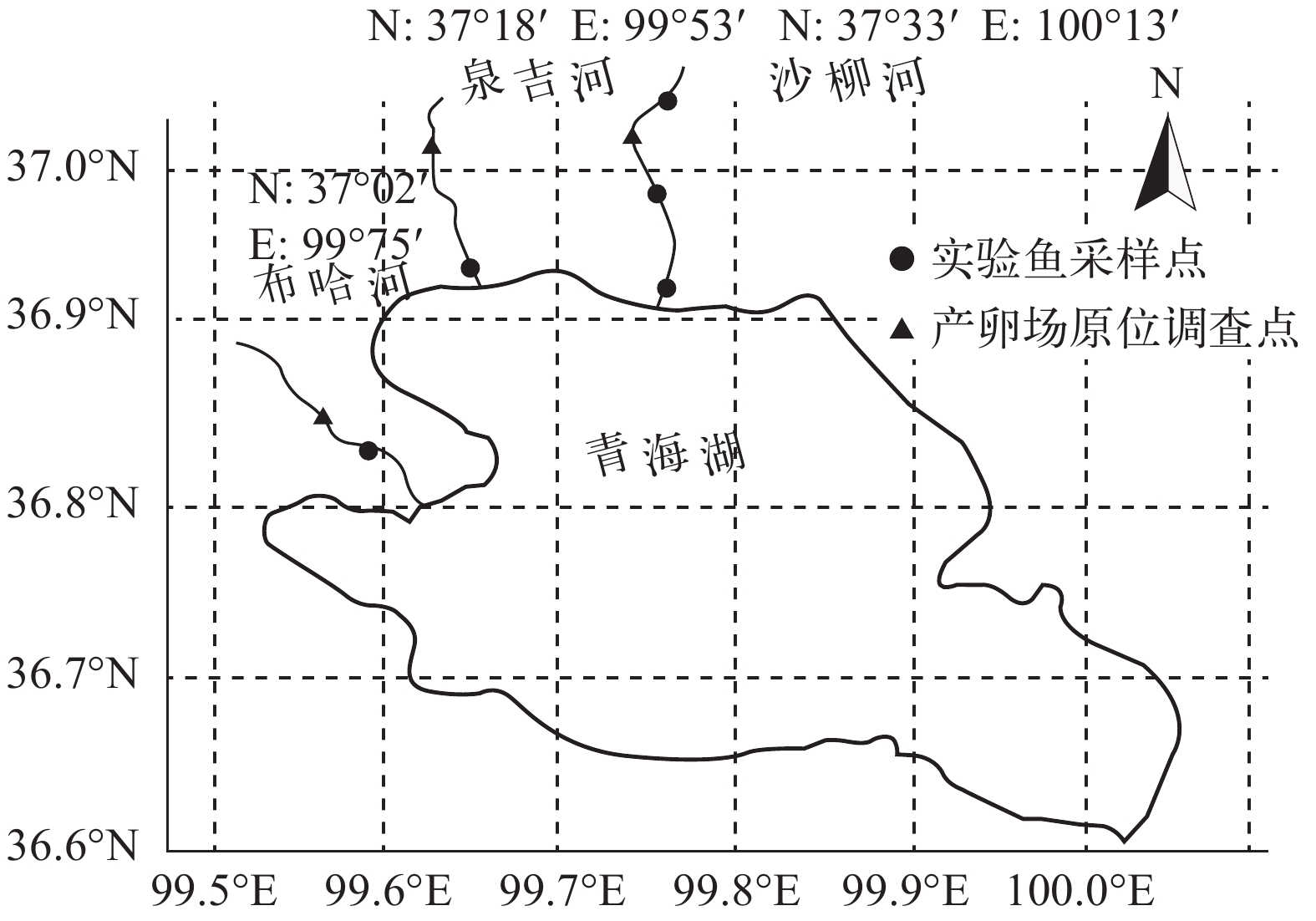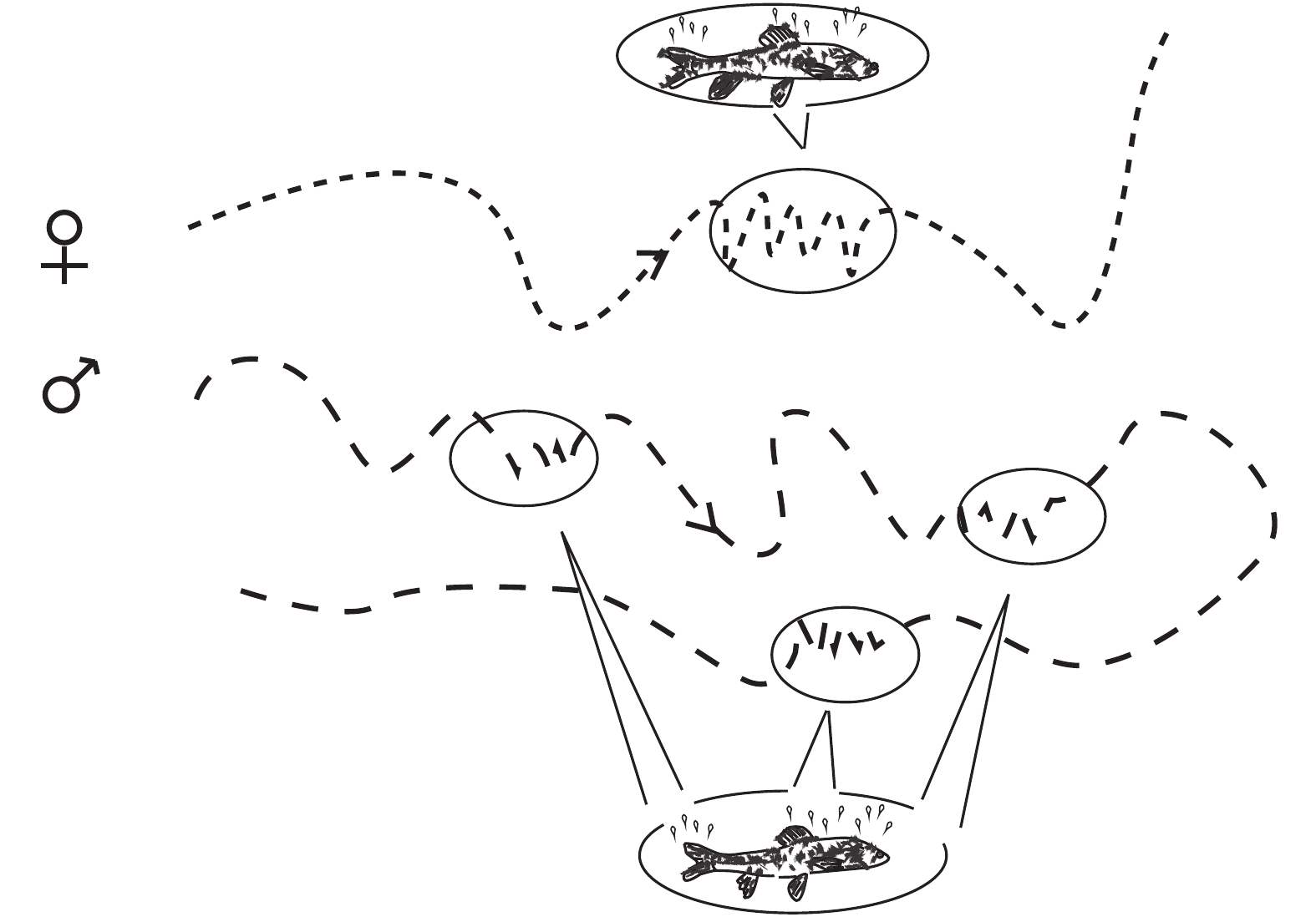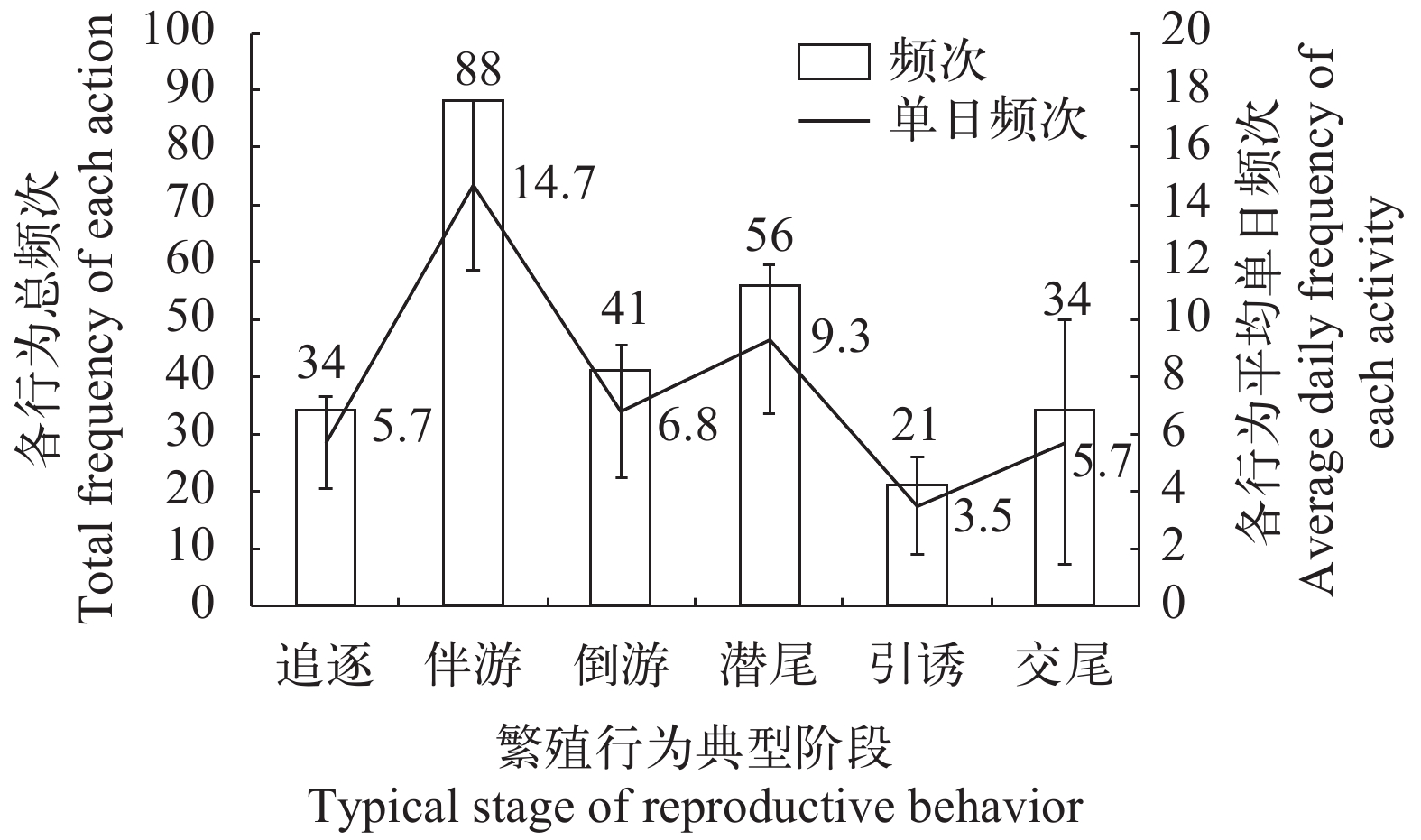REPRODUCTIVE BEHAVIORS OF GYMNOCYPRIS PRZEWALSKII IN ARTIFICIAL MIMIC SPAWNING ENVIRONMENTS
-
摘要: 研究通过人工产卵环境模拟, 成功诱导青海湖裸鲤(Gymnocypris przewalskii)自然产卵受精, 通过标志跟踪和视频监控等方法对青海湖裸鲤的繁殖行为进行了研究。结果表明, 青海湖裸鲤的繁殖过程包含了追逐、伴游、潜尾、溅戏和交尾等典型行为。其中溅戏行为(单尾雌鱼或雄鱼背鳍露出水面并用尾部拍击水面)首次被观察确认, 常被误认为是交配行为。追逐、伴游、潜尾和溅戏等繁殖行为平均频次分别为: 5.7、14.7、9.3和3.5 次/d。通过采用不同性比重复配对实验发现, 在观测到的34次交配行为中, 32次(94.1%)均为1雌和1雄配对交配。研究还发现性成熟的雌性青海湖裸鲤为一次产卵类型, 短时间内多次交尾排卵, 雌雄交配(排卵授精)行为约每天3—9次, 每次排卵耗时约4—9s, 每次平均排卵量131粒(范围15—376), 每尾雌鱼可连续交配产卵3—7d。观测到34次的交配行为中, 31次(91.1%)均发生在夜间(23: 00—次日2: 00), 3次(8.9%)发生在白天(早晨6:00—7:00)。研究首次基于人工模拟产卵环境观察描述了青海湖裸鲤的繁殖行为特征, 可为青海湖裸鲤人工产卵场构建、自然繁殖监测和产卵场保护提供科学依据。Abstract: This study investigated reproductive behaviors of Gymnocypris przewalskii in artificial mimic spawning environment by visible marker tracking and video monitoring. The typical reproductive behaviors of G. przewalskii can be divided into chasing, accompanying, diving tail, attracting and mating behaviors. Among them, the attracting behavior of the broodstocks described as surface slapping with the dorsal and pectoral fins of a single female or male fish was first confirmed, which is often mistaken for the mating behavior. The daily frequency of chasing, accompanying, diving tail and attracting behaviors were 5.7, 14.7, 9.3 and 3.5 times, respectively. 32 of 34 observed mating behaviors (94.1%) were confirmed as one female with one male. The results showed that female G. przewalskii are one-time oviposition. The frequencies of mating behaviors (spontaneously ovulating and inseminating) were 3—9 times per day and the mating durations were 4—9 seconds with an average 131 (range 15—376) eggs per time. Each female can lay eggs for 3—7 days. Among the 34 mating behaviors, 31 (91.1%) occurred at night (23:00—2:00 the next day) and 3 (8.9%) occurred during the day (6: 00—7: 00 in the morning). This study first clearly described the characteristics of reproductive behaviors of G. przewalskii ex situ, which can provide basic data for mimic-natural spawning ground construction, wild broodstock conservation and natural spawning habitat protection of G. przewalskii.
-
Keywords:
- Gymnocypris przewalskii /
- Reproduction behavior /
- Chasing /
- Companionship /
- Tail diving /
- Attracting
-
-
表 1 人工产卵环境营造参数
Table 1 Parameters of artificial spawning environment
繁殖需求Reproductive need 环境参数Environmental parameters 流速Velocity of flow (20.05±8.07) cm/s 光周期Photoperiod 14D:10L/24h 水深Water depth 20 cm 温度Temperature 10.3—13℃ 底质Bottom material 小卵石(2—5 cm) 中卵石(6—9 cm)
大卵石(10—18 cm)表 2 人工环境下不同性比实验组繁殖效果
Table 2 Reproductive results of different sex ratio experimental group in artificial environment
不同性比实验组Experimental group with different sex ratio 重复次数(次)Times of the repetition 前24h交配频次(次)Mating frequency in first 24h 前24h产卵量(颗)Eggs released in first 24h (ind.) 受精率区间Fertilization rate (%) 产卵期时长Oviposition duration (d) 产卵期平均时长Average duration of oviposition (d) 3雌1雄 8 2—6 171—2256 76.64—91.23 3—7 4 1雌1雄 8 3—9 15—988 53.33—86.67 1雌3雄 8 1—6 134—987 67.16—82.78 3雌3雄 40 4—6 17—3274 37.91—98.53 -
[1] 蒋志刚. 动物行为原理与物种保护方法 [M]. 北京: 科学出版社, 2004: 1-16. Jiang Z G. Principles of Animal Behavior and Methods of Species Conservation [M]. Beijing: Science Press, 2004: 1-16.
[2] 颜文斌, 朱挺兵, 吴兴兵, 等. 短须裂腹鱼产卵行为观察 [J]. 淡水渔业, 2017, 47(3): 9-15. doi: 10.3969/j.issn.1000-6907.2017.03.002 Yan W B, Zhu T B, Wu X B, et al. An observation of spawning behavior of Schizothorax wangchiachii [J]. Freshwater Fisheries, 2017, 47(3): 9-15. doi: 10.3969/j.issn.1000-6907.2017.03.002
[3] 张希, 孙赛, 杨宁, 等. 人工条件下暹罗斗鱼繁殖行为观察 [J]. 广东农业科学, 2011, 38(21): 126-128. doi: 10.3969/j.issn.1004-874X.2011.21.043 Zhang X, Sun S, Yang N, et al. Observation on breeding behavior of Betta splendens under artificial conditions [J]. Guangdong Agricultural Sciences, 2011, 38(21): 126-128. doi: 10.3969/j.issn.1004-874X.2011.21.043
[4] 段妍, 董婧, 李梦遥. 六线鱼属鱼类繁殖行为学研究进展 [J]. 水产科学, 2015, 34(11): 726-732. Duan Y, Dong Q, Li M Y. Research progress in reproductive behavior of greenlings [J]. Fisheries Science, 2015, 34(11): 726-732.
[5] Teresa F B, Freitas E G. Reproductive behavior and parental roles of the cichlid fish Laetacara araguaiae [J]. Neotropica Ichthyology, 2011, 9(2): 355-362. doi: 10.1590/S1679-62252011005000018
[6] Venditti, D A, James C A. Reproductive behavior and success of captive-reared chinook salmon spawning under natural conditions [J]. North American Journal of Fisheries Management, 2013, 33(1): 97-107. doi: 10.1080/02755947.2012.746244
[7] Rezucha R, Smith C, Reichard M. Personality traits, reproductive behaviour and alternative mating tactics in male European bitter ling Rhodeus amarus [J]. Behaviour, 2012, 149(5): 531-553. doi: 10.1163/156853912X643908
[8] 杨月琴, 易现峰, 李宁. 利用稳定同位素技术分析青海湖优势水鸟的营养级结构 [J]. 动物学研究, 2009, 30(4): 418-422. doi: 10.3724/SP.J.1141.2009.04418 Yang Y Q, Yi X F, Li N. Analysis on trophic structure of main waterbirds in Qinghai Lake based on stable isotopic technology [J]. Zoological Research, 2009, 30(4): 418-422. doi: 10.3724/SP.J.1141.2009.04418
[9] 熊飞. 青海湖裸鲤繁殖群体生物学 [D]. 武汉: 华中农业大学, 2003: 6-7. Xiong F. Studies on biology of spawning stocks of Gymnocypris przewalskii (Kessler) [D]. Wuhan: Huazhong Agricultural University, 2003: 6-7.
[10] 马波, 李雷, 金星, 等. 西藏雅鲁藏布江中游裂腹鱼类优先保护等级定量评价 [J]. 中国水产科学, 2019, 26(5): 914-924. Ma B, Li L, Jin X, et al. Quantitative assessment of the priority conservation of Schizothoracinae fishes in the middle Yarlung Zangbo River, Tibet [J]. Journal of Fishery Sciences of China, 2019, 26(5): 914-924.
[11] 史建全, 祁洪芳, 杨建新, 等. 青海湖裸鲤资源评析 [J]. 淡水渔业, 2000, 30(11): 38-40. doi: 10.3969/j.issn.1000-6907.2000.11.015 Shi J Q, Qi H F, Yang J X, et al. Gymnocypris przewalskii resource assessment [J]. Freshwater Fisheries, 2000, 30(11): 38-40. doi: 10.3969/j.issn.1000-6907.2000.11.015
[12] 张宏, 谭细畅, 史建全, 等. 布哈河青海湖裸鲤鱼苗鱼卵的时空分布研究 [J]. 生态科学, 2009, 28(5): 443-447. doi: 10.3969/j.issn.1008-8873.2009.05.012 Zhang H, Tan X C, Shi J Q, et al. Spatial and temporal distribution of Gymnocypris przewalskii larvae in the Buha River of the Qinghai Lake [J]. Ecological Science, 2009, 28(5): 443-447. doi: 10.3969/j.issn.1008-8873.2009.05.012
[13] 史建全, 祁洪芳, 杨建新, 等. 青海湖裸鲤人工繁殖及鱼苗培育技术的研究 [J]. 淡水渔业, 2000, 20(2): 3-6. doi: 10.3969/j.issn.1000-6907.2000.02.001 Shi J Q, Qi H F, Yang J X, et al. Studies on artificial propagation and fry culture of Gymnocypris przewalskii [J]. Freshwater fisheries, 2000, 20(2): 3-6. doi: 10.3969/j.issn.1000-6907.2000.02.001
[14] 胡安, 唐诗声, 龚生兴, 等. 青海湖地区的鱼类区系和青海湖裸鲤的生物学 [N]. 北京: 科学出版社, 1975: 49-62. Hu A, Tang S S, Gong S X, et al. Fish fauna and biology of naked carp in Qinghai Lake [N]. Beijing: Science Press, 1975: 49-62.
[15] 史健全, 唐洪玉, 祁洪芳, 等. 青海湖裸鲤性腺发育观察 [J]. 淡水渔业, 2004(3): 7-9. doi: 10.3969/j.issn.1000-6907.2004.03.002 Shi J Q, Tang H Y, Qi H F, et al. Observation on gonadal development of Gymnocypris przewalskii in Qinghai Lake [J]. Freshwater fisheries, 2004(3): 7-9. doi: 10.3969/j.issn.1000-6907.2004.03.002
[16] 乔征磊, 张洪海, 马建章, 等. 半散养东北虎繁殖期PAE编码行为谱的构建 [J]. 生态学杂志, 2015, 34(3): 736-743. Qiao Z L, Zhang H H, Ma J Z, et al. PAE coding ethogram in breeding of semi-free-ranging Amur tiger [J]. Chinese Journal of Ecology, 2015, 34(3): 736-743.
[17] 尚玉昌. 行为生态学 [M]. 北京: 北京大学出版社, 1998: 105-110. Shang Y C. Behavioral Ecology [M]. Beijing: Peking University Press, 1998: 105-110.
[18] Esteve M. Observations of spawning behaviour in Salmoninae: salmo, oncorhynchus and salvelinus [J]. Reviews in Fish Biology and Fisheries, 2005, 15(1-2): 1-21. doi: 10.1007/s11160-005-7434-7
[19] Nanami A, Sato T, Ohta I, et al. Preliminary observations of spawning behavior of white-streaked grouper (Epinephelus ongus) in an Okinawan coral reef [J]. Ichthyological Research, 2013, 60(4): 380-385. doi: 10.1007/s10228-013-0354-y
[20] 刘汉生, 易祖盛, 林小涛. 唐鱼的繁殖行为和胚胎发育研究 [J]. 水生态学杂志, 2008, 1(2): 22-27. Liu H S, Yi Z S, Lin X T. The reproductive behaviors and embryonic development of Tanichthys albonubes [J]. Journal of Hydroecology, 2008, 1(2): 22-27.
[21] Li W, Scott A P, Siefkes M J, et al. Bile acid secreted by male sea lamprey that acts as a sex pheromone [J]. Science, 2002, 138(296): 138-141.
[22] 赵世亮. 鱼类行为学进展研究 [J]. 畜牧与饲料科学, 2010, 31(9): 102-104. doi: 10.3969/j.issn.1672-5190.2010.09.050 Zhao S L. Research progress in fish ethology [J]. Animal Husbandry and Feed Science, 2010, 31(9): 102-104. doi: 10.3969/j.issn.1672-5190.2010.09.050
[23] Oliveira R F, Michael T, Brockmann H J. Alternative Reproductive Tactics (An Integrative Approach) [J]. Animal Behaviour, 2009, 85(2): 89-90.
[24] 史建全, 祁洪芳, 杨建新, 等. 青海湖裸鲤繁殖生物学的研究 [J]. 青海科技, 2000, 7(2): 12-15. Shi J Q, Qi H F, Yang J X, et al. Study on breeding biology of Gymnocypris przewalskii [J]. Qinghai Science and Technology, 2000, 7(2): 12-15.
[25] Brown C, Day R L. The future of stock enhancements: lessons for hatchery practice from conservation biology [J]. Fish Fisheries, 2010, 3(2): 79-94.
[26] Chebanov M S, Galich E V, Chmir Y N. Stock enhancement and conservation culture of sturgeons: problems and prospects [J]. Journal of Fish Biology, 2010, 65(s1): 316.
[27] Araki H, Schmid C. Is hatchery stocking a help or harm? Evidence, limitations and future directions in ecological and genetic surveys [J]. Aquaculture, 2010, 308(supp-S1): S2-S11.
[28] Johnsson J I, Brockmark S, Näslund J. Environmental effects on behavioural development consequences for fitness of captive-reared fishes in the wild [J]. Journal of Fish Biology, 2014, 85(6): 1946-1971. doi: 10.1111/jfb.12547
[29] Emmanuel M, Charles P, Lucie P, et al. Reduced fitness of Atlantic salmon released in the wild after one generation of captive breeding [J]. Evolutionary Applications, 2012, 6(3): 472-485.
[30] Joacim N, Jörgen I J. Environmental enrichment for fish in captive environments: effects of physical structures and substrates [J]. Fish Fisheries, 2016, 17(1): 1-30. doi: 10.1111/faf.12088




 下载:
下载:









